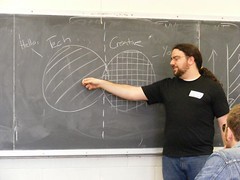Straddling the Technical/Creative Line with The New York Sun‘s Rob Blatt
Rob Blatt from The New York Sun talked in this afternoon session at PodCamp NYC 2.0 about how you can keep up with your creative and editorial motivations and ideas while keeping in mind how you can accomplish it technically.
This session was focused on the “worker bees” who wear a lot of hats, and how they can manage their time accordingly when their creative and technical sides are out of proportion.
Blatt mentioned that the “worker bees” versus “the rest” have a different perspective on how things get done. The voice personality on a podcast might not understand the crucial elements that it will take to edit it, optimize its metadata, and put it on the web. Therefore, thirty minutes after they’ve recorded a podcast, they are asking why it’s not on the web, as if their beautiful voice magically optimized, edited and coded itself.
[text_ad]
Blatt’s anecdote for these sorts of situations is not to take your colleagues ineptitudes under your wing, but to prepare them for the 21st century instead. After all, in order to manage someone who is doing something, a good manager should know how to do it themself.
Blatt recommended a blog called INDEXED where index cards are scanned into each entry. For Blatt, index cards work very well for organizing his tasks… he compared this idea to why people write down ideas on napkins and think of their best ideas in the shower. When you can’t grasp your technical side, you are in creative mode. In order to organize those thoughts, you need to put them down somewhere in order to empty your memory for more thoughts, like RAM.
“The best offense for your technical side is a good defense for your creative side, and the best defense for your creative side is a good offense for your technical side” Blatt notes.
For Blatt, index cards and working on only one project at a time works for him. Blatt emphasized looking at what you “can do” rather than what you “want to do”. He also recommended making a list of your technical questions about a project and separate them from your creative questions.
An attendee recommended the book “Do it Wrong Quickly” for people who are still stuck in old-marketing ways where you still feel the need to do it right the first time. When you create an ad for a magazine or newsletter in print, it needs to be right the first time. When you are publishing something on the web, you can change it when you want. If something you want to do to “improve” the content is holding you back from accomplishing it, you should be OK with publishing it online. Time will be available later for improvements. “If you don’t do it now, you’ll never get around to it”, a wise attendee notes.



